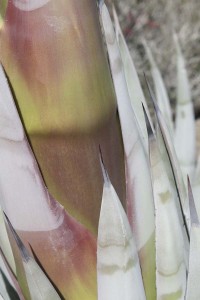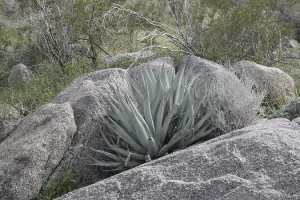A couple weekends ago Agave deserti was looking well-watered from the winter rains. This swirling mass of plants appeared to have nominated one of the cluster to go forth and flower.
Flowering is a big deal for these plants. The stalk will rise up something like ten feet from the plants central growth point. When they start out the stalks take on this gorgeous pink and green coloration, which contrasts against the nearly white rosettes of the main plants.
I couldn’t help myself from getting a little abstract and arty with this extreme cropping of this closeup. It’s really such a neat phenomenon that you can appreciate all sorts of ways.
Once it blooms the main growth point dies. Critters relish the seed, so these don’t always get a chance to reproduce that way. Fortunately they have the fallback of throwing one or more pups from the base of the plant. Once a plant has bloomed and pupped a few times you can get a striking grouping of genetically identical plants called a genet. The first photo of this post is a nice example.
The plants were all over the slopes of Plum Canyon at Anza-Borrego Desert State Park. But occasionally you’d see the agaves setting up household in unlikely places, like this rock cleft. It makes for a nice photo though I’m not so sure about what it bodes for a lifetime anchored in this one spot. The plants didn’t appear any too concerned, however.
I leave you with a closeup of a single plant of a larger genet. Wikipedia says that a single individual out of a genet is called a ramet. I learn something new every day.
Although many agaves grow in perfect, implacable rosettes, so that you can almost see a mathematical purity in their patterns, the desert agave seems to celebrate a looser, wilder approach to life. You can almost envision a vortex of desert wind blowing just looking at these leaves.
All in all a gorgeous species!
I’ll have more desert plant photos as I work through the files on my camera…






